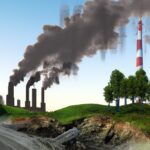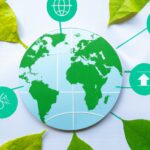Excerpt:
Pollution is a pressing concern, and its causes are multifaceted. One of the leading causes is industrial activities, which release large amounts of harmful chemicals and pollutants into the air, water, and soil. Emissions from vehicles, both personal and commercial, contribute significantly to air pollution, especially in urban areas. Deforestation and the burning of fossil fuels also release substantial amounts of carbon dioxide into the atmosphere, leading to climate change and air pollution. Additionally, agricultural practices, such as the use of pesticides and fertilizers, contribute to water pollution as these chemicals seep into the soil and waterways. Understanding and addressing these causes is crucial in mitigating the devastating effects of pollution on our environment and health.
Air pollution is caused by various factors, including industrial emissions, vehicle exhaust, and burning of fossil fuels. These activities release harmful pollutants such as carbon dioxide, sulfur dioxide, nitrogen oxides, and particulate matter into the atmosphere. These pollutants contribute to the greenhouse effect and result in the depletion of the ozone layer.
Water pollution occurs due to the discharge of industrial waste, agricultural runoff, and improper sewage treatment. Industries release toxic chemicals into rivers and lakes, leading to the contamination of water sources. In agriculture, pesticides and fertilizers used in excess can seep into groundwater or runoff into water bodies, causing pollution. Inadequate treatment of sewage also adds to water pollution.
Another major cause of pollution is soil contamination. This occurs due to the deposition of heavy metals, toxic chemicals, and pesticides, which can affect agricultural productivity and pose a threat to ecosystems. Improper disposal of industrial waste and garbage also contribute to soil pollution.
Noise pollution is caused by excessive noise from various sources, such as traffic, construction activities, industrial machinery, and loud music. Continuous exposure to high noise levels can lead to hearing impairments, stress, and other health issues.
Light pollution occurs due to the excessive use of artificial lighting, which disrupts natural ecosystems and disturbs the sleep patterns of humans and animals. This disruption can affect wildlife behavior, biodiversity, and overall ecological balance.
Lastly, pollution can also be caused by improper waste management. Inadequate waste disposal practices, such as open burning of waste or dumping in landfills without proper measures, lead to the release of toxins into the environment, contributing to pollution.
In conclusion, pollution is caused by multiple factors, including air and water emissions from industries and vehicles, improper waste management, agricultural practices, and excessive noise and light. Understanding these causes is essential in developing effective strategies to reduce pollution and protect our environment.
Sources of pollution
Sources of pollution can be categorized into various types, each contributing to environmental degradation in its own way. These sources can be classified as natural or anthropogenic, referring to pollution caused by human activities. Let’s explore some of the main sources of pollution:
1. Industrial Emissions: Industries play a significant role in pollution, releasing harmful substances into the air, water, and soil. Industrial emissions include pollutants such as smoke, gases, particulate matter, and chemical wastes. Factories, power plants, refineries, and manufacturing units contribute to atmospheric pollution, water pollution, and soil contamination.
2. Vehicle Emissions: Automobiles, trucks, and other vehicles emit harmful gases and particulate matter into the atmosphere. Exhaust fumes from vehicles release pollutants like carbon monoxide, nitrogen oxides, and volatile organic compounds (VOCs), which contribute to air pollution and smog formation. Road transportation is a major source of pollution in urban areas.
3. Agricultural Activities: Agriculture, while necessary for food production, can also contribute to pollution. The use of chemical fertilizers, pesticides, and herbicides can contaminate soil and water sources, impacting ecosystems and human health. Additionally, the burning of agricultural waste, such as crop residues, emits smoke and pollutants into the air.
4. Deforestation: Forests act as natural filters, absorbing carbon dioxide and releasing oxygen, thereby mitigating pollution. Deforestation increases the concentration of greenhouse gases, leading to climate change and air pollution. Additionally, the removal of trees disrupts ecosystems, causing habitat loss and extinction of species.
5. Waste Disposal: Improper waste disposal and management can lead to pollution in various forms. The dumping of solid waste in landfills produces methane gas, a potent greenhouse gas. Inadequate treatment of sewage and industrial waste results in water pollution, making water bodies unfit for human and aquatic life.
6. Construction and Demolition: Construction activities generate dust, noise, and debris, contributing to air and noise pollution. The release of construction materials like cement, chemicals, and asbestos can contaminate soil and water sources if not handled properly. Demolition projects also produce substantial amounts of waste.
7. Mining: Extracting natural resources through mining can lead to pollution of air, water, and soil. Mining activities release dust and fumes, polluting the air with harmful particles. Contaminants from mining waste can leach into nearby water bodies, affecting aquatic ecosystems and human health.
8. Energy Production: The production and use of energy, particularly from fossil fuels, contribute to pollution. Power plants that burn coal, oil, or gas emit pollutants such as sulfur dioxide, nitrogen oxides, and greenhouse gases. These emissions not only contribute to air pollution but also contribute to global warming.
9. Chemical and Industrial Accidents: Accidental releases of hazardous substances from chemical plants, oil spills, or industrial accidents can have severe environmental consequences. These incidents can contaminate air, water, and soil, affecting ecosystems, wildlife, and human populations.
Understanding the sources of pollution is crucial for developing effective strategies to minimize and prevent environmental contamination. By addressing these sources through technological advancements, policy changes, and public awareness, we can reduce pollution and work towards a healthier and sustainable future.
Effects of pollution
Effects of pollution:
Pollution has wide-ranging and detrimental effects on both the environment and human health. The consequences of pollution are significant and can be immediate as well as long-term. In this section, we will explore the various effects of pollution.
1. Environmental Impact:
Pollution is known to severely impact the environment in numerous ways. Air pollution, primarily caused by the burning of fossil fuels, industrial activities, and vehicular emissions, leads to the formation of smog and acid rain. Smog reduces visibility, causes respiratory problems, and negatively affects wildlife. Acid rain, on the other hand, damages forests, soil, and water bodies, leading to the decline of plant and animal species.
2. Water Contamination:
Water pollution, mainly caused by industrial waste, agricultural runoff, and improper disposal of chemical waste, has devastating effects on aquatic ecosystems. Contaminated water sources affect marine life, making it difficult for plants to photosynthesize and affecting the breeding and survival of fish and other aquatic organisms. It can also lead to the contamination of drinking water sources, posing a severe risk to human health.
3. Soil Degradation:
Pollution adversely affects soil quality and fertility. The release of toxic chemicals into the soil through agricultural practices, industrial waste, and improper disposal of hazardous substances can lead to reduced crop yields, decreased soil productivity, and the loss of biodiversity. Soil pollution also affects the quality of food produced, as crops absorb pollutants, which can then be transferred to humans and animals upon consumption.
4. Climate Change:
Pollution contributes significantly to climate change. The release of greenhouse gases, such as carbon dioxide and methane, from industrial activities and the burning of fossil fuels leads to the greenhouse effect. This traps heat within the Earth’s atmosphere, causing global temperatures to rise. Climate change has far-reaching consequences, including rising sea levels, extreme weather events, and the displacement of communities and ecosystems.
5. Health Impacts:
Pollution has severe implications for human health. Exposure to air pollutants, such as fine particulate matter, ozone, sulfur dioxide, and nitrogen oxides, can cause respiratory problems, cardiovascular diseases, and lung cancer. Water pollution can lead to the spread of waterborne diseases, such as cholera, dysentery, and hepatitis. Moreover, the consumption of contaminated food can result in poisoning and other health issues.
In conclusion, pollution has a profound and often irreversible impact on the environment and human health. It not only affects our natural surroundings but also jeopardizes our well-being. Adequate measures need to be taken to reduce pollution levels and promote sustainable practices to mitigate these effects and safeguard the planet for future generations.
Environmental impacts of pollution
Environmental impacts of pollution are extensive and severely affect various aspects of our planet. Pollution, in all its forms, significantly alters the functioning and balance of ecosystems, leading to a wide range of negative consequences.
One of the most evident environmental impacts of pollution is the degradation of air quality. Air pollution, caused primarily by the release of pollutants from industries, vehicles, and burning of fossil fuels, poses a serious threat to human health and the environment. The presence of pollutants such as particulate matter, nitrogen oxides, sulfur dioxide, and volatile organic compounds in the air can lead to respiratory problems, cardiovascular diseases, and even premature death. It also contributes to the formation of smog and acid rain, which further pollute the air, water, and soil.
Water pollution is another significant environmental impact caused by pollution. Contamination of water bodies, including rivers, lakes, oceans, and groundwater, not only affects aquatic life but also poses a threat to human health. Industrial discharges, agricultural runoff, and improper waste disposal result in the presence of harmful substances like heavy metals, pesticides, fertilizers, and sewage in water sources. This contamination leads to the destruction of aquatic habitats, the reduction of biodiversity, and the transmission of water-borne diseases.
Soil pollution is closely linked with water pollution, as contaminated water can seep into the soil, adversely impacting its quality and fertility. The excessive use of chemical fertilizers, pesticides, and improper disposal of industrial waste contribute to soil pollution. The presence of toxic substances in the soil hampers its ability to support plant growth and disrupts the natural cycles within ecosystems. This, in turn, affects agriculture productivity, leads to loss of biodiversity, and can result in long-term environmental degradation.
Pollution not only affects air, water, and soil but also has far-reaching consequences on biodiversity. The release of pollutants alters ecosystems, disrupting the delicate balance between species and their habitats. Environmental pollution contributes to the decline and even extinction of many plant and animal species. It alters food chains and reduces the availability of resources, ultimately leading to imbalances in ecosystems and the overall loss of biodiversity.
Furthermore, pollution has a detrimental impact on climate change. The release of greenhouse gases such as carbon dioxide, methane, and nitrous oxide from industrial activities, deforestation, and burning of fossil fuels leads to global warming. This, in turn, causes changes in weather patterns, rising sea levels, and extreme weather events, which have widespread negative consequences for both the environment and human societies.
In conclusion, pollution has severe environmental impacts across air, water, soil, biodiversity, and climate. It disrupts natural processes, damages ecosystems, poses health risks to both humans and wildlife, and contributes to climate change. Addressing pollution and finding sustainable solutions are vital to protecting the environment and ensuring a healthy future for our planet.
Health impacts of pollution
Health impacts of pollution can be severe and far-reaching, affecting individuals, communities, and even entire populations. The presence of pollutants in the air, water, and soil can have detrimental effects on human health, leading to various diseases and health conditions. Here are some key aspects of the health impacts of pollution:
1. Respiratory problems: One of the most prominent health effects of pollution is respiratory issues. Inhalation of polluted air, especially containing fine particulate matter (PM2.5) and harmful gases, can lead to respiratory conditions such as asthma, bronchitis, and chronic obstructive pulmonary disease (COPD). These conditions can cause coughing, wheezing, shortness of breath, and reduced lung function.
2. Cardiovascular diseases: Pollution has been linked to an increased risk of cardiovascular diseases. Exposure to air pollutants like nitrogen dioxide (NO2) and particulate matter can lead to the development of cardiovascular conditions such as heart attacks, strokes, and hypertension. These pollutants can enter the bloodstream, triggering inflammation, oxidative stress, and the formation of blood clots.
3. Allergies and skin problems: Pollutants can also trigger allergic reactions and skin problems. Certain chemicals found in air pollution can result in allergic rhinitis (hay fever) and exacerbate existing allergies. Additionally, pollutants can cause skin rashes, irritation, and other dermatological issues, particularly when there is direct contact with contaminated water or toxic substances.
4. Cancer: Prolonged exposure to certain pollutants, such as asbestos, benzene, and certain airborne toxins, increases the risk of developing cancer. Pollution-related cancers include lung, bladder, liver, and skin cancers, among others. Pollutants can damage DNA, disrupt cellular functions, and promote the growth of cancer cells within the body.
5. Neurological effects: Recent research indicates that pollution can have adverse effects on the nervous system and cognitive functions. Exposure to pollutants like lead, mercury, and pesticides has been associated with neurological disorders such as developmental delays in children, cognitive impairments, and an increased risk of neurodegenerative diseases like Alzheimer’s and Parkinson’s.
6. Reproductive health: Pollution can also have negative impacts on reproductive health. Some pollutants, including endocrine disruptors like phthalates and certain pesticides, can disrupt hormone balance and impair fertility in both males and females. Exposure to certain pollutants during pregnancy can also lead to complications, birth defects, and developmental issues in newborns.
7. Mental health: While the physical health impacts of pollution are well-documented, emerging evidence suggests a link between pollution and mental health problems. Studies indicate that exposure to air pollution can increase the risk of mental health disorders such as anxiety, depression, and even suicidal thoughts. The mechanisms by which pollution affects mental health are still being researched but may involve systemic inflammation, oxidative stress, and neuroinflammation.
Overall, the health impacts of pollution are multifaceted and wide-ranging. The severity of these effects depends on the type and level of pollutants, as well as an individual’s susceptibility and exposure duration. Efforts to reduce pollution and promote clean environments are crucial not only for environmental conservation but also for safeguarding public health.
Prevention and solutions to pollution
Prevention and solutions to pollution:
Preventing pollution and finding effective solutions to address it are crucial for safeguarding the environment and promoting a sustainable future. Pollution can have detrimental impacts on ecosystems, human health, and the overall quality of life. Therefore, implementing preventive measures and seeking solutions are imperative. Here are some key strategies and actions that can be taken to alleviate pollution:
1. Improving industrial processes: Industries are major contributors to pollution, releasing harmful substances into the air, water, and soil. Implementing cleaner production methods, optimizing energy efficiency, and adopting advanced technologies can significantly reduce pollution by minimizing emissions and waste generation.
2. Promoting renewable energy sources: Transitioning from fossil fuels to renewable energy sources such as solar, wind, and hydro power can significantly reduce air pollution caused by the burning of fossil fuels. Increasing the share of renewable energy in the energy mix is an effective solution to mitigating pollution and combatting climate change.
3. Enhancing waste management: Proper waste management practices, such as recycling, composting, and responsible disposal, can help minimize pollution. By reducing the amount of waste sent to landfills and incinerators, valuable resources can be conserved, and the release of harmful pollutants into the environment can be minimized.
4. Strict emission controls: Governments should enforce stringent regulations regarding emissions from vehicles, power plants, and other industrial sources. This can be achieved by setting emission standards, instituting regular inspections, and promoting the use of emission control technologies. Retrofitting old vehicles and installing pollution control devices on industrial chimneys are effective measures in reducing air pollution.
5. Conserving water resources: Water pollution is a significant environmental issue that requires preventive measures. Implementing wastewater treatment plants, encouraging responsible agricultural practices, and reducing the use of harmful chemicals can help protect water bodies from pollution.
6. Raising awareness and education: Educating individuals and communities about the causes and effects of pollution is crucial in preventing and finding solutions to pollution. Promoting environmental awareness, sustainable practices, and responsible consumerism can bring about positive changes in behavior and habits, leading to a reduction in pollution levels.
7. Encouraging green transportation: Promoting alternative modes of transportation, such as cycling, walking, and public transit, can help reduce air pollution caused by vehicle emissions. Investing in efficient and eco-friendly public transportation systems, as well as developing infrastructure for electric vehicles, can also contribute to pollution reduction.
8. Implementing policies and incentives: Governments should establish policies and fiscal incentives that encourage businesses and individuals to adopt cleaner technologies and practices. This can include tax benefits for renewable energy projects, subsidies for eco-friendly products, and penalties for non-compliance with pollution control measures.
In conclusion, prevention and solutions to pollution require collective efforts from various stakeholders, including governments, industries, communities, and individuals. By implementing these measures and supporting sustainable practices, we can work towards reducing pollution, protecting the environment, and ensuring a healthier future for generations to come.













